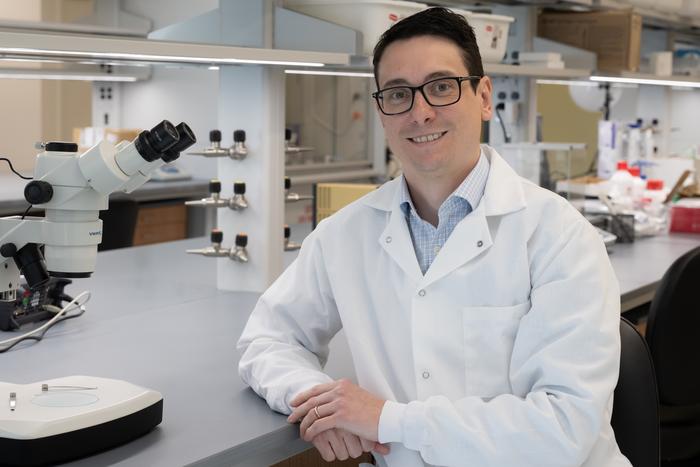HOUSTON – In a remarkable serendipitous encounter, a collaborative research venture led by scientists from Rice University, the University of Cambridge, and Stanford University has significantly advanced the production of PEDOT:PSS, a composite polymer that has become vital in both biomedical applications and computing technologies. For more than two decades, the traditional technique for enhancing the material’s stability involved the addition of a chemical crosslinker, a method that complicated manufacturing processes and potentially introduced variability into the final product’s performance. However, the recent innovation spurred by doctoral student Siddharth Doshi’s experimentation suggests a more efficient pathway.
During his research focused on refining the patterning of PEDOT:PSS for biomedical optics, Doshi discovered that omitting the crosslinker while simultaneously applying higher temperatures could yield a robust product with inherent stability. This pivotal moment prompted a deeper inquiry into the underlying mechanisms responsible for the resulting material’s newfound resilience in aqueous environments. The implications of this discovery are substantial, as they propose a manufacturing method that does not just simplify processes but also improves the quality of the resultant devices.
The findings reveal that heating PEDOT:PSS beyond customary preparation thresholds fundamentally alters the material’s structure, eliminating the necessity for crosslinking agents while enhancing its properties. As documented in a study published in Advanced Materials, this breakthrough could revolutionize the fabrication of bioelectronic devices, streamlining production and expanding their possible applications in areas such as neural implants and advanced computing systems. The ability to create a more stable platform for interfacing with biological tissues is critical, particularly in fields that demand extreme precision and reliability.
The polymer’s dual conductive nature, capable of facilitating both electronic and ionic charge, is central to its role in bridging technology and living tissues. This duality allows devices made from PEDOT:PSS to effectively interact with the human nervous system, which operates primarily through ionic signals. By eliminating the need for potentially toxic crosslinkers, the new method simplifies the synthesis process and heralds improvements in electrical performance — including a threefold increase in conductivity. This enhancement signifies a crucial advantage for applications in medical settings where reliable functionality is paramount.
Prior to this research, the challenges posed by crosslinkers, which help bind the composite polymer strands into a coherent mesh, often left the water-soluble components exposed to instability. The new approach of applying heat resolves these stability concerns by inducing a phase change in the polymer, reorganizing its internal structure and pushing the less stable components to the surface where they can be washed away. What remains is a purer, more effective conducting film that exhibits consistent properties batch after batch, critical for producing reliable medical devices.
Moreover, the team’s exploration did not just yield a more stable material; it also opened the door for miniaturization and 3D customization of PEDOT:PSS structures. Innovative techniques employing precision laser heating can now allow for the creation of microscopic three-dimensional textures, enhancing cellular integration and providing better quality signals in neuroelectronic devices. This advancement is poised to greatly benefit implantable technologies, such as spinal cord stimulators or arrays for electrocorticography, as they necessitate effective implantation and integration within the body’s own systems.
Biological compatibility is crucial; thus, understanding how PEDOT:PSS can be engineered to support cellular behavior is a major breakthrough that could transform neurotechnology. Devices constructed from the heat-treated polymer demonstrate resilience and sustained performance, with experiments showcasing their stability exceeding 20 days post-implantation. As researchers like Keene emphasize, the alignment of micrometer-scale textures with biological cellular dimensions could promote a higher degree of tissue integration, a feature crucial for the utility and longevity of bioelectronic implants.
This transition away from traditional crosslinking methods may also resolve historical issues related to stability that previous technologies, including those developed by Neuralink, faced. With enhanced reliability provided by the new fabrication method, the pathway is now clearer for advancing neurotechnological devices that could potentially restore movement and provide interfaces linking the brain to external devices.
In conjunction with these revelations, the researchers’ foray into fine-scale 3D printing of PEDOT:PSS holds the promise of unprecedented customizability in materials science. By fine-tuning the properties of this conductive polymer through microstructuring, scientists may enhance how these materials interact with biological systems, opening new avenues for innovative biomedical applications. The ability to meticulously design how cells interact with the polymer will undoubtedly propel research into efficient bioelectronic systems forward.
As this research gains traction, the implications stretch beyond material stability and performance. The more reliable and functional PEDOT:PSS opens a myriad of possibilities for next-generation computing systems that harness brain-like processing capabilities. Keene’s insights into the neural analogs of firmware could pave the way for artificial memory systems that better emulate the brain’s learning processes, offering a compelling glimpse into the future of AI-enhanced technologies that could learn and adapt like biological entities.
Ultimately, the collaborative effort not only dismantled a long-held assumption that the crosslinker was essential for PEDOT:PSS’s stability but also unveiled a robust alternative that simplifies and amplifies the properties of this pivotal conductive polymer. By fostering an understanding that merges material science with intricate biological systems, this research represents a significant leap forward in bioelectronics, potentially culminating in safer, more accessible neural interfaces that could profoundly enhance healthcare and human-machine interaction.
The implications of this research are vast, highlighting its potential benefits across various domains from medical technology to artificial intelligence, setting the stage for ongoing exploration within the fields of advanced materials and bioengineering.
Subject of Research: Thermal processing of PEDOT:PSS for bioelectronics
Article Title: Thermal processing creates water-stable PEDOT:PSS films for bioelectronics
News Publication Date: March 3, 2025
Web References: Rice University News
References: Advanced Materials, DOI: 10.1002/adma.202415827
Image Credits: Jeff Fitlow/Rice University




